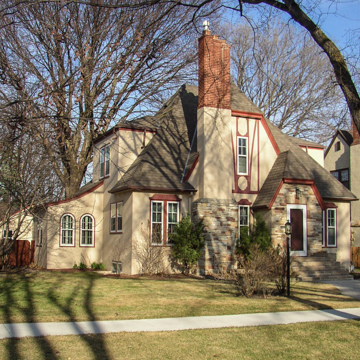Unlike the more eclectic South Eighth Street Residential neighborhood (CS27), the North Fargo Builders’ Residential District is notable for the consistency of style among its small- to moderately sized houses. Most of the houses are Tudor Revival and were built from the 1920s to the 1940s. Local carpenter-builders such as Emil Brant, Eric Edlund, and Olaf Anderson—many of them Scandinavian immigrants and father-and-son construction teams—built one or two houses a year on a speculative basis. Most were based on published pattern-book designs and few were the products of creative architectural input, although there are houses in the neighborhood designed by Paul W. Jones and S. Marius Houkom. The houses, many of them smaller than nine hundred square feet in area, make effective use of handcrafted and picturesque details. Curved sidewalks and extensive landscape development give the neighborhood a well-integrated feeling of unity and harmony. Mature elm trees branch over the north-south streets to give the impressive effect of an arched canopy.
You are here
North Fargo Builders’ Residential Historic District
If SAH Archipedia has been useful to you, please consider supporting it.
SAH Archipedia tells the story of the United States through its buildings, landscapes, and cities. This freely available resource empowers the public with authoritative knowledge that deepens their understanding and appreciation of the built environment. But the Society of Architectural Historians, which created SAH Archipedia with University of Virginia Press, needs your support to maintain the high-caliber research, writing, photography, cartography, editing, design, and programming that make SAH Archipedia a trusted online resource available to all who value the history of place, heritage tourism, and learning.















